Active Protection Systems Market Size and Trends
The active protection systems market is estimated to be valued at US$ 4.55 Bn in 2025 and is expected to reach US$ 6.76 Bn by 2032, growing at a compound annual growth rate (CAGR) of 5.8% from 2025 to 2032. Increasing defense budgets as well as rising threats have driven the growth of active protection systems especially across North America and Europe.
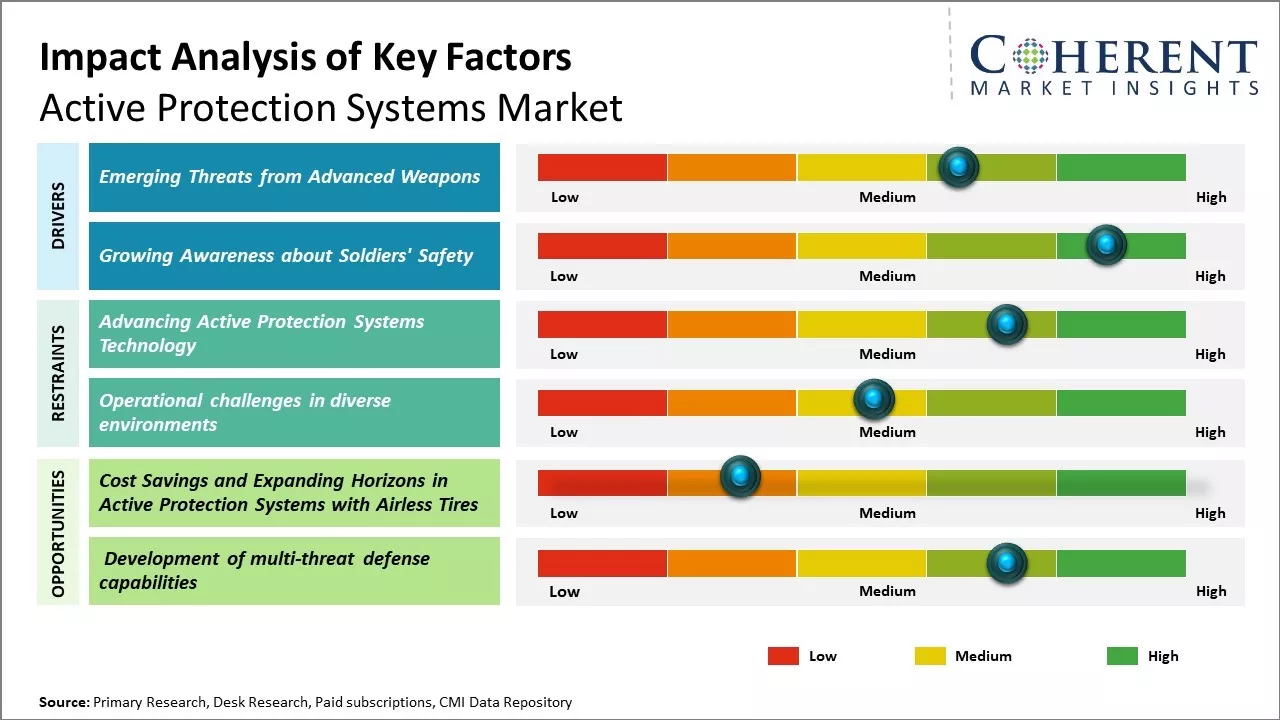
Discover market dynamics shaping the industry: Download Free Sample
The demand for active protection systems is expected to significantly rise during the forecast period owing to the growing incidences of asymmetric warfare worldwide. The integration of lasers and hard-kill interceptors is anticipated to provide greater protection against advanced threats. Moreover, the development of lightweight and low-cost active protection solutions suitable for armored vehicles and ships will further aid the market expansion.
Market Concentration and Competitive Landscape
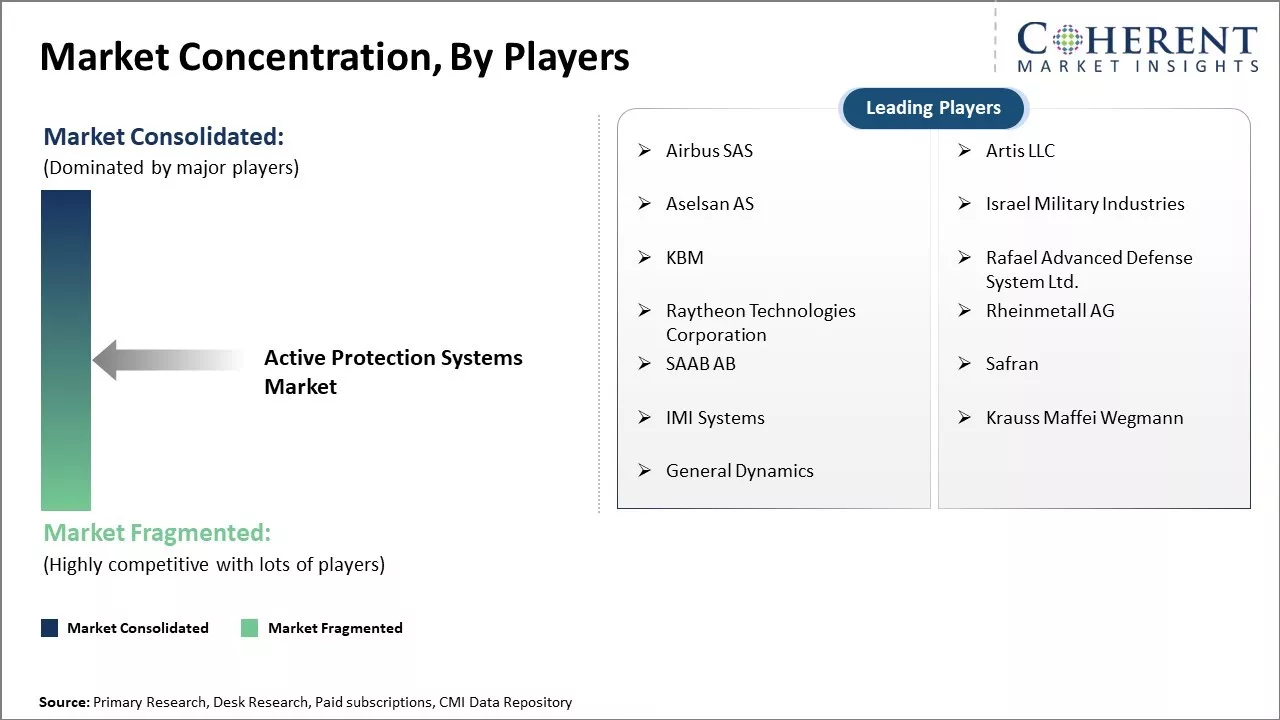
Get actionable strategies to beat competition: Download Free Sample
Emerging Threats from Advanced WeaponsWith the advancement in weapon systems and technologies, threats on the battlefield have become stronger and lethal. Countries around the globe are constantly working on developing sophisticated missiles, shells, rockets, and other ammunitions to gain superiority over their adversaries. These weapons are equipped with advanced guidance systems that make them accurate and difficult to intercept. Tanks and fighting vehicles today are vulnerable to new generation anti-tank guided missiles and rocket propelled grenades that can easily penetrate their armor. Soldiers on the ground also have to deal with improved improvised explosive devices and car bombs. The weapons are also larger in size and have longer ranges. For example, the Chinese DF-21D and DF-26 anti-ship ballistic missiles have ranges over thousand miles which threaten overseas military bases and aircraft carriers. Advanced air defense systems make airspace heavily contested. Such emerging threats demand active protection for military assets rather than passive armor alone. Countries need solutions that can reliably neutralize incoming threats before they make impact. This is driving greater investment in new Active Protection Systems (APS) that employ hard kill technology along with sensors and countermeasures. APS promises multi-functional defense through hard-kill interceptor munitions paired with early warning detection. Militaries see APS as a must-have capability for future battles.
Growing Awareness about Soldiers' Safety
While militaries aim to gain supremacy, there is also a humanitarian aspect of minimizing casualties on the battlefield. No country wants to see harm come to their troops. With post-traumatic stress disorders and mental health issues in soldiers receiving more attention than before, protecting human life is becoming equally important. Conventional armor provides protection from small arms fire and shell splinters but cannot guarantee survival against advanced anti-tank weapons. Passively waiting to take a hit puts lives at high risk. Therefore, ensuring safety of troops engaged in combat missions has risen as a key priority. It is where APS, with its ability to actively intercept and destroy incoming projectiles before they strike, finds more takers. Recent conflicts have highlighted the need for extra shielding for soldiers inside armored platforms. As combat morphs into urban settings against non-state actors, even light utility vehicles require adequate countermeasures. Human factor is a leading consideration driving the demand for active protection mechanisms that can create an impenetrable shield around men and machines on the edge.
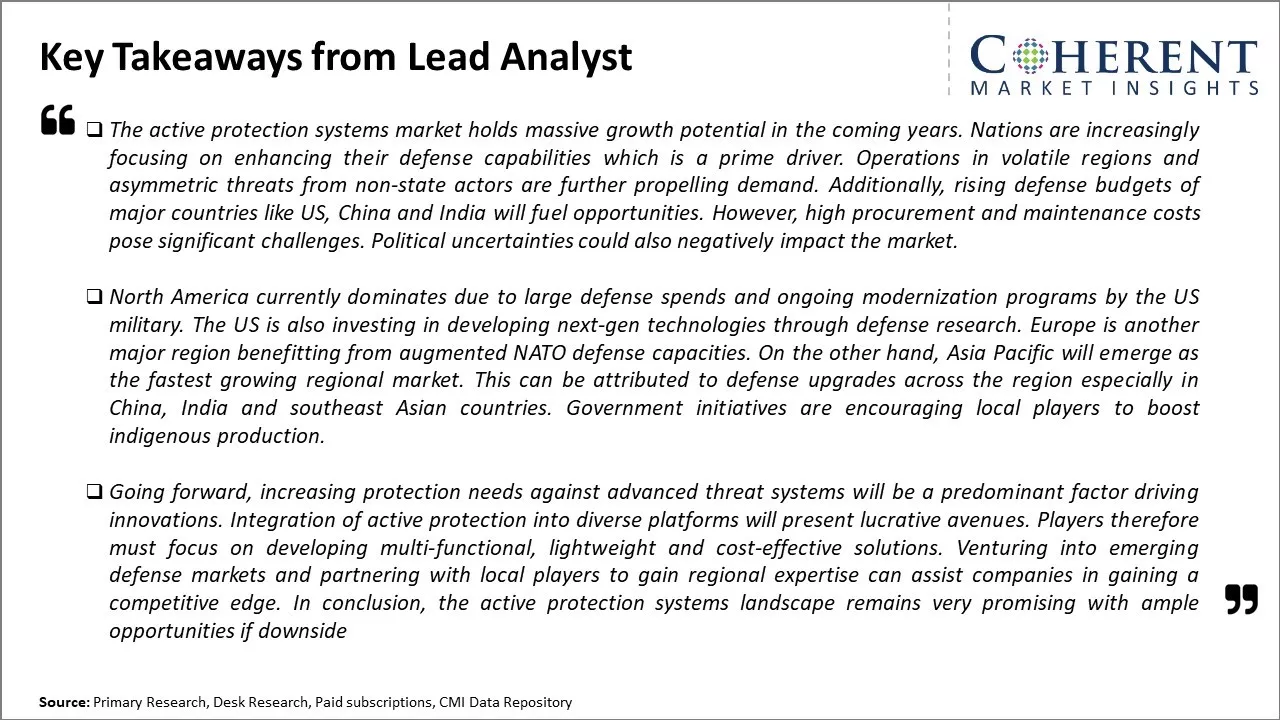
To learn more about this report, Download Free Sample
Market Challenges: Advancing Active Protection Systems TechnologyThe active protection systems market faces the challenge of high research and development costs associated with producing cutting edge technology that can effectively neutralize incoming threats. Continuous technological advancements are required in interceptor missiles, arena countermeasures, and other defenses to counter evolving threats. However, the expense of maintaining an edge in this arena poses a barrier to greater adoption across all military platforms.
Market Opportunities: Expanding Horizons in Advance Active Protection Systems Technology
As the nature of conflict evolves with new asymmetric and multidimensional threats, militaries globally are seeking innovative ways to protect valuable assets like tanks, combat vehicles, and naval vessels. The active protection systems market has an opportunity to grow substantially by developing cost-effective and reliable solutions that can address a wide range of threats. Improving active protection technology also creates export opportunities as countries look to enhance the survivability of their forces.
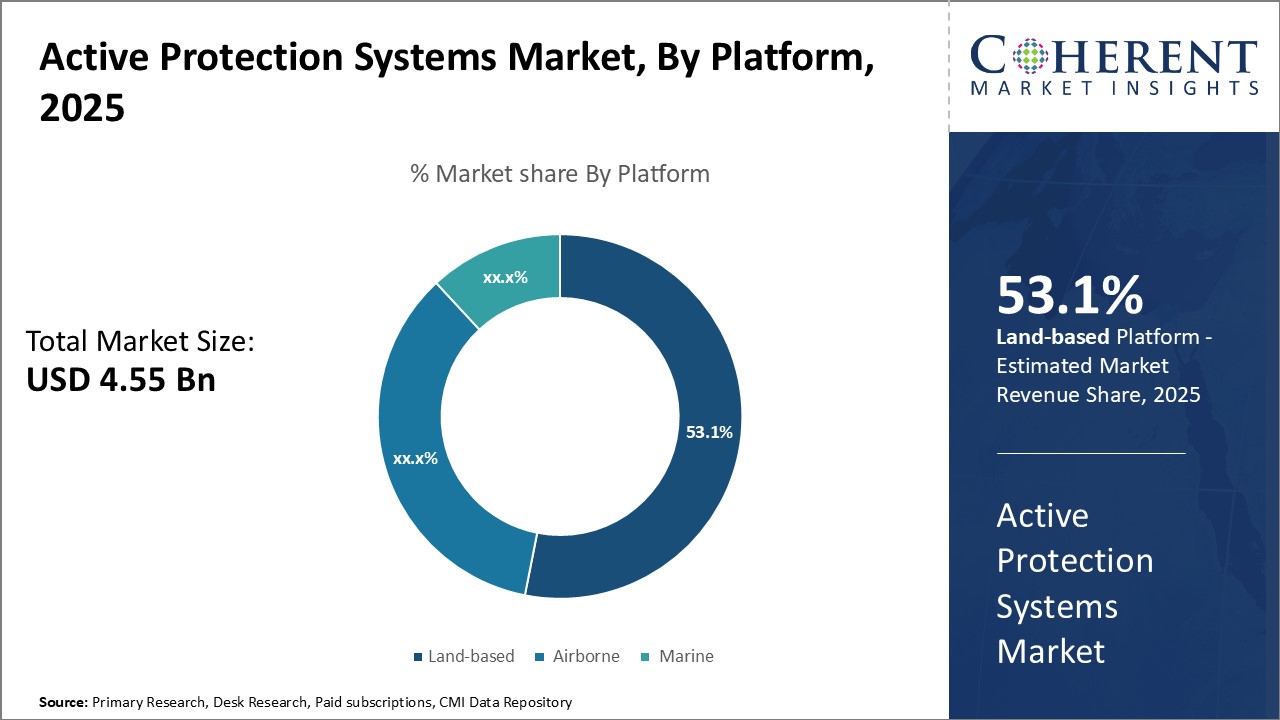
Discover high revenue pocket segments and roadmap to it: Download Free Sample
Insights By Platform- Air Superiority Drives the Airborne SegmentIn terms of platform, airborne contributes 53.1% the highest share of the active protection systems market owing to the need for protecting combat and non-combat aircraft from modern threats. Air forces around the world are continuously becoming more advanced with stealth capabilities and long range precision strike weapons. This places a higher priority on protecting air assets to maintain air superiority. The airborne segment leads the others due to the critical importance of aircraft survival and mission capability in modern aerial warfare.
Systems installed on aircraft must be lightweight and compact while still providing robust protection. They also need to have sophisticated detection capabilities to track incoming threats from all angles of approach. Hard kill interceptors are widely used as the only viable option for protecting fast moving planes and helicopters. Directed energy technologies show promise but still have challenges to overcome in terms of power requirements and space constraints. Overall protection systems must not interfere with aerodynamic performance or onboard sensors and weapons. Satisfying all these factors has driven extensive research and development spending toward improving airborne active protection.
Pilot safety is another major consideration for the airborne segment. Ejecting from a damaged aircraft comes with high risks, so internal defenses that neutralize threats before impact are invaluable. They allow planes to return safely if hit rather than becoming lost assets. Transport and medevac helicopters in particular draw from this life-saving capability. As aviation missions shift toward unmanned platforms, similar protections will be required for preserving expensive drone assets and payloads. The demand for robust and specialized systems from the high-risk airborne environment makes it the primary focus and technology leader.
Insights By System Type, Hard kill system contributes the highest share of the market owing to its proven effectiveness against advanced threats
Hard kill systems have market share of 40.5% and they have established themselves as the premier option for active protection due to their unparalleled ability to neutralize incoming projectiles. These systems utilize interceptor munitions or built-in hard-kill defenses that can physically destroy threats such as anti-tank guided missiles and rocket-propelled grenades. Unlike softer alternatives, hard kill systems guarantee the elimination of threats via contact detonation or fragmentation.
This contact engagement capability has underscored hard kill systems' popularity among military operators tasked with defending heavily armored vehicles and strategic assets. Top tier militaries around the world have especially favored these systems for their frontline units operating in volatile regions where threats from advanced anti-armor munitions persistently endanger troops. With sophisticated threats like fire-and-forget missiles proliferating to lesser militaries and non-state actors, the hardness of interception provided by hard kill systems has become integral to mission accomplishment and crew survivability.
The confirmation of hard kill systems against real-world threats through countermeasures also enhances confidence among defense planners. Operators simply trust in the ultimate lethality these systems bring to bear compared to alternatives like soft kill systems. This trust, built on demonstrated reliability under pressure, cements the demand for hard-kill defenses as the preeminent active protection technology of the present and future.
Insights By Solution - Versatile Hardware Dominates the Market
In terms of solution, the hardware segment contributes 60.5% the maximum share of the active protection systems market due to the versatility of physical interceptors and modular armor units. Across all platforms, hardware acts as the primary interface delivering kinetic defenses. Sophisticated sensors and processors are useless without effective on-board mechanisms to intercept threats. Modular launchers, interceptor missiles, and active/reactive armor are the core elements providing real-time protection through destruction or deflection.
Advancements in materials science and miniaturization have boosted hardware capabilities tremendously. Smaller and more powerful interceptor missiles can now engage multiple targets. Advanced ceramics and active protection tiles can withstand multiple impacts while maintaining protective coverage. Autonomous counterattack drones extend engagement envelopes without adding size and weight. Plug-and-play active armor also helps switch out damaged sections faster, lowering downtimes.
As the interface between detections and neutralizations, responsive and precise hardware remain central to any active protection concept. Software solutions aim to improve efficiencies but cannot replace the need for physical defenses. Upgrades in interceptor seeker algorithms or armor materials still require retrofitting onto existing vehicle fleets. This fitment advantage and greater returns on research investment have established hardware as the anchor for the solution segment. Customizable effector modules will continue meeting evolving battlefield needs.
Regional Insights
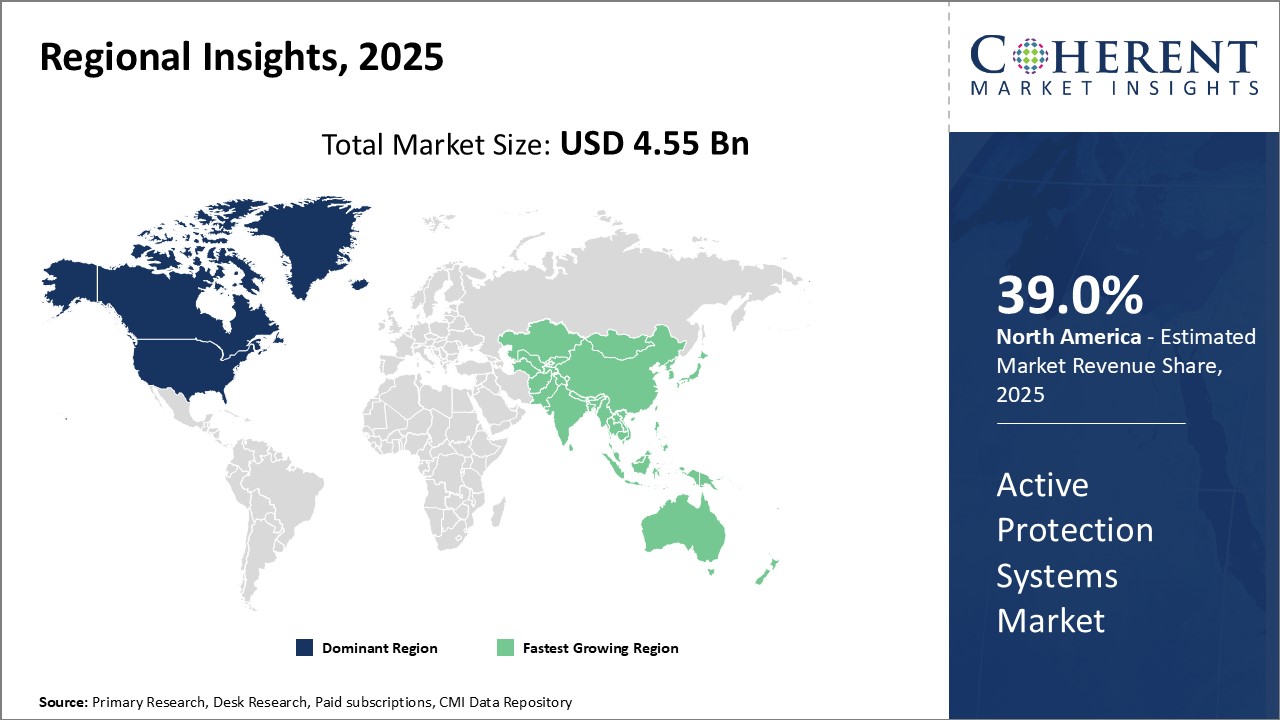
Need a Different Region or Segment? Download Free Sample
North America have market share of 39.0% and established itself as the dominant regional market for active protection systems. This is largely due to strong defense budgets and ongoing military modernization programs by key countries in the region such as the U.S. and Canada. Several tier 1 defense contractors with extensive capabilities in this field such as Raytheon, Lockheed Martin and General Dynamics operate from within North America, driving significant research and development activities. Major programs like the US Army's Stryker APS upgrade provides a steady demand pipeline for regional suppliers. With the presence of domestic manufacturing bases, North America also has competitive pricing and logistics advantages for original equipment manufacturers based in the region.
Asia Pacific has emerged as the fastest growing regional market for active protection systems in recent years. Several factors contribute to this rapid growth including rising defense budgets and modernization priorities across countries like India, China, and South Korea. For example, the Indian army has an ambitious tank modernization initiative that is expected to upgrade over 1,500 tanks with domestic or imported active protection suites over the coming decade. Similarly, the increasing defense collaboration between China and Russia has also aided technology transfers and co-development of advanced APS for vehicles like main battle tanks and infantry fighting vehicles. Furthermore, nations like South Korea have taken steps to improve protection capabilities of key vehicles due to threats from North Korea. The strong manufacturing ecosystem for defense technologies in Asia Pacific coupled with focus on indigenization is driving the regional market expansion. Original equipment manufacturers are also increasingly looking at this region for manufacture, assembly, and export of active protection systems.
Market Report Scope
Active Protection Systems Market Report Coverage
| Report Coverage | Details | ||
|---|---|---|---|
| Base Year: | 2024 | Market Size in 2025: | USD 4.55 Bn |
| Historical Data for: | 2020 To 2024 | Forecast Period: | 2025 To 2032 |
| Forecast Period 2025 to 2032 CAGR: | 5.8% | 2032 Value Projection: | USD 6.76 Bn |
| Geographies covered: |
|
||
| Segments covered: |
|
||
| Companies covered: |
Airbus SAS, Artis LLC, Aselsan AS, Israel Military Industries, KBM, Rafael Advanced Defense System Ltd., Raytheon Technologies Corporation, Rheinmetall AG, SAAB AB, Safran, IMI Systems, Krauss Maffei Wegmann, and General Dynamics |
||
| Growth Drivers: |
|
||
| Restraints & Challenges: |
|
||
Uncover macros and micros vetted on 75+ parameters: Get instant access to report
Active Protection Systems Industry News
- In July 2022, Elbit Systems Limited a global defense technology company specializing in a wide range of aerospace, land, and naval solutions has won an US$80 million contract to provide Electronic Warfare (EW) systems and Direct Infrared Counter Measures (DIRCM) to Asia Pacific region
- In May 2022, Turkey announced plans to start mass-producing its battle tanks. These 65-ton tanks will be fitted with Aselsan APS, offering defense against top-attack anti-tank guided munitions like the Javelin.
- In May 2022, Raytheon Missiles & Defense is a premier provider of cutting-edge missile systems and defense solutions has secured a US$423 million contract with the U.S. Navy to continue producing SPY-6 radars. These radars can defend against surface ships, cruise missiles, hostile aircraft, and ballistic missiles simultaneously.
- In April 2022, Cobham Advanced Electronic Solutions (CAES) is a trusted leader in providing advanced electronic solutions for critical applications in aerospace, defense, and other industries has agreed on a contract with Lockheed Martin Corporation for an initial production phase-1. CAES will supply Phased Array Antennas to support Lockheed Martin's Advanced Off-Board Electronic Warfare (AOEW) system.
- In November 2021, General Dynamics European Land Systems (GDELS), Rafael Advanced Defense Systems (Rafael), and Krauss-Maffei Wegmann (KMW) formed a joint venture called EuroTrophy. This Germany-based company will market and sell the Trophy Active Protection System (APS) to European markets.
- In March 2021, L3Harris is a top-tier global aerospace and defense technology company delivering innovative solutions for mission-critical challenges across air, land, and sea, space, and cyber domains has revealed its intentions to develop a new electronic warfare suite for F-16s being sold to international partners. This system creates a virtual electronic shield around the aircraft.
*Definition: The active protection systems market consists of systems designed to protect armored vehicles from advanced anti-tank missiles and rocket-propelled grenades. These systems use sensors to detect incoming projectiles and countermeasures such as smoke screens or interceptor projectiles to destroy threats before impact. Major defense contractors manufacture active protection systems for military vehicles to defend against modern anti-tank weapons.
Market Segmentation
- Platform Insights (Revenue, US$ BN, 2020 - 2032)
- Land-based
- Airborne
- Marine
- System Type Insights (Revenue, US$ BN, 2020 - 2032)
- Soft Kill System
- Hard Kill System
- Reactive Armor
- Solution Insights (Revenue, US$ BN, 2020 - 2032)
- Hardware
- Software
- End User Insights (Revenue, US$ BN, 2020 - 2032)
- Defense
- Homeland Security
- Regional Insights (Revenue, US$ BN, 2020 - 2032)
- North America
- U.S.
- Canada
- Latin America
- Brazil
- Argentina
- Mexico
- Rest of Latin America
- Europe
- Germany
- U.K.
- France
- Italy
- Russia
- Rest of Europe
- Asia Pacific
- China
- India
- Japan
- Australia
- South Korea
- ASEAN
- Rest of Asia Pacific
- Middle East & Africa
- GCC Countries
- South Africa
- Rest of Middle East & Africa
- North America
- Key Players Insights
- Airbus SAS
- Artis LLC
- Aselsan AS
- Israel Military Industries
- KBM
- Rafael Advanced Defense System Ltd.
- Raytheon Technologies Corporation
- Rheinmetall AG
- SAAB AB
- Safran
- IMI Systems
- Krauss Maffei Wegmann
- General Dynamics
Share
Share
About Author
Suraj Bhanudas Jagtap is a seasoned Senior Management Consultant with over 7 years of experience. He has served Fortune 500 companies and startups, helping clients with cross broader expansion and market entry access strategies. He has played significant role in offering strategic viewpoints and actionable insights for various client’s projects including demand analysis, and competitive analysis, identifying right channel partner among others.
Missing comfort of reading report in your local language? Find your preferred language :
Transform your Strategy with Exclusive Trending Reports :
Frequently Asked Questions
EXISTING CLIENTELE
Joining thousands of companies around the world committed to making the Excellent Business Solutions.
View All Our Clients
